Asexuality is an umbrella term for a sexual orientation spectrum unified by the lack of experiencing sexual attraction towards other people. As opposed to celibacy which is a choice to abstain from sex, asexuality is intrinsic like any other sexual orientation. A lack of sexual attraction does not always inherently mean that someone does not experience other forms of attraction like romantic, aesthetic, or sensual. Like any other identity, the way asexuality manifests will vary from individual to individual. Some asexual people still enjoy the act of sex, while others are sex-repulsed. Furthermore, asexuality may be coupled with any type of romantic attraction but not always. Asexuality is a completely valid sexuality and is not to be confused with any dysfunction or fundamental lacking. Being that some asexual people still experience romantic attraction, it’s likely that not every person they will be romantically attracted to will also be asexual. This difference in sexual orientation has the potential to cause friction in a relationship if it’s not explicitly and intentionally addressed. Here are some ideas for broaching this topic with your partner.
It’s vital for the allosexual (non-asexual) partner(s) to keep in mind that asexuality, like any other sexual orientation, is not a choice. It is never okay to lash out at an asexual person for something they cannot control. Remember, approach this as you and your partner(s) against the problem, not you versus one another. The problem is the mismatch in needs, not the asexual person’s orientation.
Evaluate the tangible sexual needs of all partner(s). Before being able to figure out how to make sure everyone’s needs are being fulfilled, you need to understand what those needs are. In Embrace Sexual Wellness’s blog article, “How to Determine and Communicate Boundaries in Relationships” you can find ways to discover and communicate your needs.
Brainstorm solutions outside of the box. Consider options like ethical non-monogamy, scheduled sex for a guaranteed frequency (if the asexual partner is open to having sex), and nurturing other types of intimacy.
Remember, this can be a tricky situation to navigate for anyone. There is no shame in seeking out help from professionals like the clinicians at Embrace Sexual Wellness. A third party can facilitate a more productive, effective conversation which may be the jumpstart you and your partner(s) need to tackle this challenge.





























